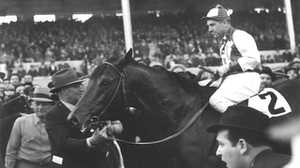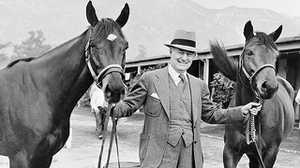"Seabiscuit-itis"

In the late 1930s, as the Depression hovered persistently over the nation, Americans turned to one newsmaker with joyous devotion. His name was Seabiscuit. One sportswriter called the nation’s addiction “Seabiscuit-itis.”
Popular Athlete
“He may have been in his time the most popular athlete that America has ever produced,” says Laura Hillenbrand, author of Seabiscuit: An American Legend. The horse’s popularity was fueled by his remarkable feats on racecourses, but the man who owned the horse, Charles Howard, stoked the fires of Seabiscuit’s fame. Howard had made a fortune using innovative marketing ploys. As a San Francisco distributor for Buick, he had offered driving lessons to uncertain buyers, and accepted horses as trade-ins. But in 1936, at the age of 59, he turned a lifetime of selling skills to his newest prospect: Seabiscuit.
Making a Superstar
“Charles Howard invented sports marketing,” Hillenbrand says. “He would woo the press every chance he got. He didn’t want for this horse only to be successful. He wanted him to be a superstar in America. In pursuit of column inches, Howard sent reporters champagne and called them up with scoops. In 1938, as a result of Howard’s constant promotion and his horse’s exciting races, Seabiscuit got more ink than President Franklin Roosevelt or Nazi leader Adolf Hitler.
Spokeshorse
Behind Howard and the press came marketers who knew there was a buck to be made on the back of such a popular racehorse. Railroads advertised “Seabiscuit Limited” trains to take fans to his races. People carried their betting money in Seabiscuit wallets, and those who had a little extra money in those wallets could splurge at Fifth Avenue shops to buy fancy Seabiscuit hats. Race fans could play any of nine commercially-marketed games that bore the horse’s name. There were Seabiscuit toys and Seabiscuit wastebaskets. His image was used to promote dry cleaning services, hotels and a pinball game. His profile was even slapped on crates bearing Seabiscuit oranges.
The Rumor Mill
Seabiscuit inspired the kind of rumors that usually develop about Hollywood stars. One inventive scribe wrote that trainer Tom Smith poured two quarts of Golden Rod beer for Seabiscuit to drink before each race. If this brew is denied the stallion, the imaginative writer wrote, the horse “whinnies and stomps to indicate displeasure.” The Chicago Tribune joked in the summer of 1938 that “as a result of his Maryland victory, Seabiscuit will get the Rhett Butler role in Gone with the Wind.”
The Height of the Frenzy
Americans developed extreme cases of Seabiscuit-itis in the months prior to his 1938 matchup against the Eastern-bred champion War Admiral. But excitement mounted even higher in late 1939 when Howard announced that the horse, in a comeback from a bad injury, would race for the $100,000 winner-take-all prize that had previously eluded him at the Santa Anita Handicap. Movie theaters from coast to coast showed newsreel footage of Seabiscuit’s races, which got top billing over the the new Jimmy Stewart feature. (The Story of Seabiscuit, starring Shirley Temple, would not be released until 1949.) Shortly after noon on the day of the race, Seabiscuit’s competition on the entertainment pages began to arrive at the racetrack: Jack Benny, Tyrone Power, James Stewart, Clark Gable, Carole Lombard, and Bing Crosby.
Believe the Hype
In a country with about half the population of today, 78,000 fans, about the size of a current Super Bowl crowd, came to watch the star horse’s last race. As if to prove to all that the hype was not a commercial exaggeration, Seabiscuit clocked the fastest mile-and-a-quarter in Santa Anita’s history, which was the second-fastest time ever run for that distance on an American track. It’s considered one of the greatest comebacks in the history of American sports. “Oh,” wrote columnist Jolly Roger, “that I have lived to see this day.”







